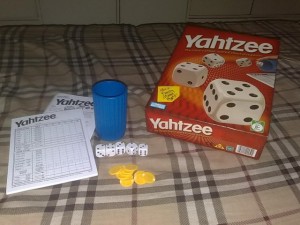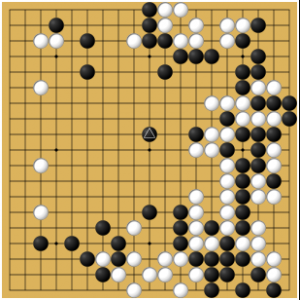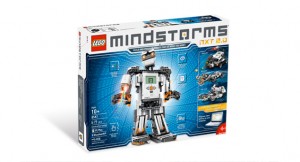We live in an interesting time where new technologies are radically reforming how humans interact with machines and with each other. The field of education is no exception. Tech savvy teachers are likely to be familiar with new educational paradigms like BYOD, MOOC, and flipped classrooms. There’s more to this movement than just fancy buzzwords. Teachers are forging ahead into new territory by bringing technology into the classroom and looking for ways to make the most of it. As these technologies continue to improve, these hi-tech classrooms are starting to look like something out of a science fiction story.
Many scientific advances have had their roots in science fiction. It seems pertinent then to examine how science fiction authors have depicted the future of education as a source of inspiration for the hi-tech classroom. In this post, we’ll take a look at some Sci-Fi classrooms and see what lessons we can learn from them.
The sources
The following are a collection of Sci-Fi classrooms from sources that I’m familiar with. I’m sure this list is not exhaustive, so please feel free to contribute others in the comments. Also, please note that some of these source materials are intended for mature audiences. I’ll try avoid any major spoilers for those who are unfamiliar with them.
Starship Troopers
Based on a novel by Robert Heinlein, Starship Troopers takes place in a future where democracy has crumbled and replaced with a militarist establishment. Humanity is engaged in an interstellar war against alien species, and enlisting in the military is the most efficient path to “citizenship”.
The beginning of the film depicts the protagonist, Rico, in a high school history class. Despite the futuristic setting, the classroom largely fits the “traditional lecture” paradigm. Rico’s history teacher is a retired officer who is missing an arm. The course is arguably equal parts history and propaganda.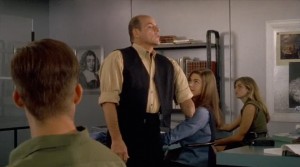
While there isn’t much use of technology in the classroom, each desk seems to have a touch sensitive computer embedding in it. For Rico, this seems to be more of a distraction from the class than a learning aid.
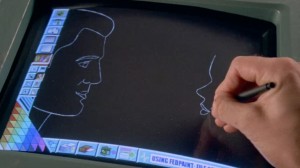
The high school experience ends with high stakes testing. A low math score ultimately places Rico into the infantry while his close friends are placed in flight school and military intelligence. For added pressure, students seem to check their test scores on a public computer terminal.
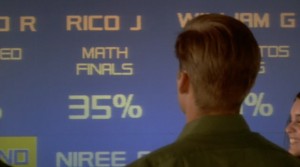
We also get a glimpse of a futuristic biology lab, in which students dissect alien lifeforms.
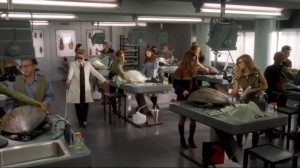
While the lectures, labs, and high stakes testing are all too familiar, the film does raise interesting questions about the purpose of education. The school is structured like a factory to produce potential soldiers. It’s easy to see why this militaristic society would structure education in such a way that cultivates students that efficiently follow orders. I tend to view this as a cautionary tale of what education might become in the hands of a powerful military bureaucracy.
WALL-E
WALL-E follows the adventures of a trash compacting robot in a world where Earth’s natural resources have been extinguished by rampant consumerism. With the Earth no longer capable of supporting life, the remaining population leaves the planet in large intergalactic cruise ships. In the film, we observe a brief scene depicting a futuristic pre-school.
In this scene, a number of small children are watching a video with a computerized narrator describing the letters of the alphabet. No adults are present in the room and the instruction is fully provided by a robot. This picture of education fits with the overall premise of the film, in that humans have essentially automated themselves into irrelevance.
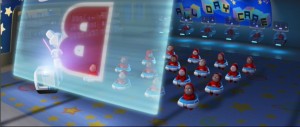
Like Starship Troopers, the educational system is designed to perpetuate the existing authority. Even in this pre-school setting, students are conditioned by messages such as “B is for Buy-N-Large, your very best friend”. It’s implied later in the film that the residents of this spaceship are taught very little about life on the planet that their ancestors fled. The system is programmed to keep the residents living happily on the ship, and inhibiting any curiosity about to the circumstances that put them there. The residents are fat, happy and ignorant, and the fully automated educational system is designed to keep them that way.
Serenity
Based on the Firefly TV series, Serenity treats us to a brief glimpse of River Tam’s childhood. The young River has been identified as intellectually gifted and is sent to “The Academy”.
In this scene, River is taking part in a history course. It begins with the teacher narrating in front of a holographic projection that displays a visual depiction of the events. The lesson describes the “Unification War”, in which a number of planets rebelled against the Alliance’s expansion. The teacher explains that the Alliance engaged in this war to spread peace throughout the galaxy and asks why the rebels would resist. River seems to suspect that there’s more to the story and points out that “people don’t like to be meddled with”.
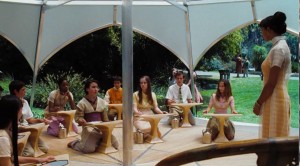
While this looks like a typical lecture classroom, each of the students appears to have touch sensitive computer screen embedded in the desks. Students seem to be interacting with the computer during the lecture using a stylus, but also are engaged in note taking with a traditional pen and paper.
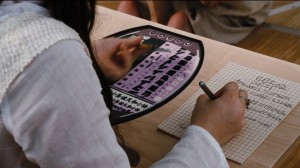
We later find out that the Academy is actually a front for a program to turn these students in super-soldiers through a series of cruel medical and psychological experiments. River’s skepticism of the Alliance’s meddling turns out to be quite prescient.
Star Trek
In the 2009 film Star Trek, we find one of the more visually striking Sci-Fi classrooms. A young Spock is depicted in a school for Vulcans, a race known for their strong devotion to logical reasoning. The scene shows students in semi-spherical pods, where the students interact with a projected display. Several adults can be seen walking between these learning pods, but the main source of instruction appears to be with the computer.
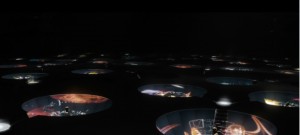
The computer asks the students various questions, particularly involving science and mathematics, and the student responds verbally with the answers.
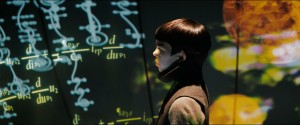
As the young Spock completes his interactive instruction, he is met by several other students who proceed to bully him about his human mother.
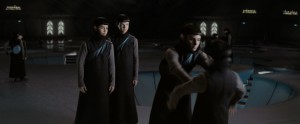
The young Spock fights back out of anger, a course of action which is looked down upon in a society that values emotional restraint.
Star Trek: Voyager
Within the Star Trek universe, the TV series Star Trek: Voyager provides another perspective on education. The star-ship Voyager gets lost in space after travelling through a worm hole and spends many years heading back home. In this time, one of the crew-members gives birth on board the ship. The child, Naomi Wildman, grows up aboard the star-ship and is essentially home-schooled by the crew.
The details on Naomi’s education are limited, but she takes a liking to the Borg crew-member Seven of Nine who serves as a mentor. On occasion, Seven will assign her various instructional materials or ask her to carry out small tasks on the ship. Several other crewmembers serve as teachers as well. Naomi works diligently on these tasks and aspires to become the Captain’s Assistant.
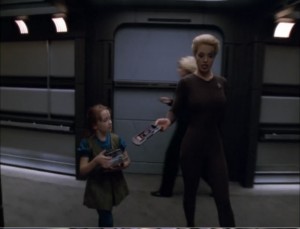
We also know that Naoimi spends a good deal of time on board the ship’s holodeck. It’s implied that some of Naomi’s education comes from interactive holographic children’s tales like “The Adventures of Flotter”. This colorful interactive fairy tale is designed to teach children deductive reasoning skills, and Naomi needs to solve several puzzle to help the storyline progress.
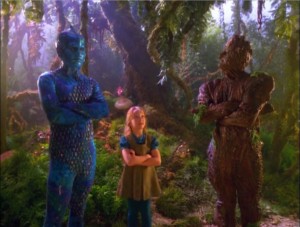
In a later episode, the crew picks up several Borg children and the educational offering on Voyager are expanded to meet their needs. This results in the First Annual Voyager Science Fair. Naomi presents a model of planet, while the Borg children present a clone potato, an ant colony and a gravimetric sensor.
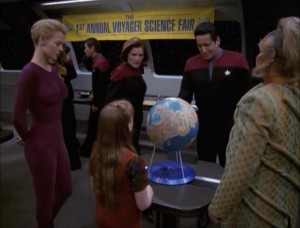
Accel World
Accel World is a manga and anime by Reki Kawahara set in a future where humans can interface with computers via a “Neuro-Linker”. This hardware allows individuals to interact in a virtual environment using thoughts to control their personal computer. The opening episode of Accel World depicts what looks like a typical classroom: a teacher at the front of the class lectures while the students are busy taking notes. The difference is that the teacher isn’t actually writing on the board, but rather the hand movements of the teacher are transcribed to a digital blackboard which the students can see through the neural-interfaced computer.
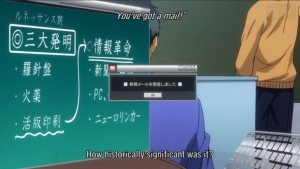
We also see that all of the students are busy using hand gestures to control these computers throughout the class.
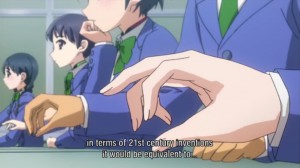
Like Star Trek, the synchronous nature of the classroom causes problems for the protagonist. Haru is short fat kid with low self-esteem who is regularly bullied by students that are bigger than him.
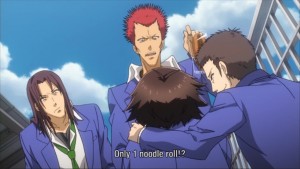
To Haru, the virtual reality system provided by the Neuro-Linker is his only escape from the hostile environment of reality. When a classmate offers him a strange program that will “destroy his reality”, he eagerly seizes the opportunity.
Ready Player One
Ernest Cline’s novel Ready Player One takes place largely within an interactive simulation called OASIS. In a world that has been ravaged by climate change and a crumbling democracy, the brick and mortar schools are a potentially hostile environment and the protagonist, Wade, volunteered to pilot an educational program in this virtual environment. Users access the OASIS using a combination of a virtual reality visor, haptic gloves (and other accessories) and voice control. Wade’s school is one of many in OASIS and he describes some of the advantages of a virtual school:
There were hundreds of school campuses here on Ludus, spread out evenly across the planet’s surface. The schools were all identical, because the same construction code was copied and pasted into a different location whenever a new school was needed. And since the buildings were just pieces of software, their design wasn’t limited by monetary constraints, or even by the laws of physics. So every school was a grand palace of learning, with polished marble hallways, cathedral-like classrooms, zero-g gymnasiums, and virtual libraries containing every (school board–approved) book ever written.
On my first day at OPS #1873, I thought I’d died and gone to heaven. Now, instead of running a gauntlet of bullies and drug addicts on my walk to school each morning, I went straight to my hideout and stayed there all day. Best of all, in the OASIS, no one could tell that I was fat, that I had acne, or that I wore the same shabby clothes every week. Bullies couldn’t pelt me with spitballs, give me atomic wedgies, or pummel me by the bike rack after school. No one could even touch me. In here, I was safe.
When I arrived in my World History classroom, several students were already seated at their desks. Their avatars all sat motionless, with their eyes closed. This was a signal that they were “engaged,” meaning they were currently on phone calls, browsing the Web, or logged into chat rooms. It was poor OASIS etiquette to try to talk to an engaged avatar.They usually just ignored you, and you’d get an automated message telling you to piss off.
I took a seat at my desk and tapped the Engage icon at the edge of my display. My own avatar’s eyes slid shut, but I could still see my surroundings. I tapped another icon, and a large two-dimensional Web browser window appeared, suspended in space directly in front of me. Windows like this one were visible to only my avatar, so no one could read over my shoulder (unless I selected the option to allow it).
School in OASIS bears a marked a resemblance to the traditional classroom. Students attend classes synchronously in the virtual environment. A teacher leads the class in something like a lecture format, but this lecture can be supplemented by virtual materials that would be impossible in a traditional class. For example, students can take a virtual tour of the human body on board a microscopic submarine in Biology. Students have opportunities to interact with each other as well and a “mute user” option makes it possible to avoid virtual bullying.
I think it’s also worth mention that this type of virtual school is quite possible with today’s technology. For example, virtual schools already exist in Second Life.
Common Themes
While this is a small sample of Sci-Fi classrooms, I think there are some patterns here that are worth noting.
Education is an institution of great power
First and foremost, these Sci-Fi stories depict education as a very powerful force in human development. This is something of a double-edged sword. Education can be used as a tool to enlighten individuals or it can be used to preserve a system of authority.
There’s an old maxim stating that “knowledge is power”. Sci-Fi takes this maxim one step further by showing us worlds where restricting access to knowledge can make individuals powerless. As a society, we need to take steps to ensure that information is open and available to avoid falling into a trap of historical revisionism.
Lectures are here to stay
Most of these Sci-Fi classrooms seem to fit the template of the “traditional lecture”. A teacher stands in front of the class and delivers information to the students. Perhaps part of the reason for this is that the “lecture” is so pervasive in our culture that we wouldn’t recognize these as classrooms if they were structured otherwise. Our familiarity with the format means that we quickly recognize the scene as a “school”. This format allows the Sci-Fi plot to make its point and move on in a short amount of time.
Despite the dated classroom format, the technology in the classroom opens up new methods of presenting information. The chalkboards have gone electronic and the Power Point slides have been replaced by holographic projections. The interesting part is that despite all this technology, these Sci-Fi classrooms often still have a human teacher. Computers might be used to disseminate information, but learning is guided by a “real teacher”. This suggests that the role model that teachers provides is an important part of the educational process. The teacher is trusted to make an appropriate use of the technology to engage students in the practice of critical thinking.
School is a social experience
Another related trend in these Sci-Fi classrooms, is that the students gather in the same place at the same time. This suggests that students interacting with each other is an important part of the school experience.
This is particularly curious in the case of Star Trek and makes for an interesting comparison with present day hybrid courses. In a typical hybrid course, students have both asynchronous “homework” time (typically done over the Internet) and synchronous “classroom” time. What’s interesting to me about the Vulcan classroom is that it a synchronous environment with primarily asynchronous instruction. During the instructional time, students interact primarily with the computer rather than each other. It might be comparable with an online class that you were required to take in person.
It may be that the concurrency of having students gathered in a single location is to support the development of social skills, but in the case of several protagonists this has the negative side effect of bullying. Ready Player One solves this bullying issue by transitioning to a fully virtual classroom. Students can simply block electronic messages from others if they choose.
Conclusion
While we obviously don’t want to base educational practices on anecdotes from science fiction, I think that these Sci-Fi stories mirror the struggles of today’s teachers. On one hand, teachers want to adhere to practices that have worked in the past. One the other hand, teachers can see the value in exposing students to new technology. What we see in these Sci-Fi classrooms is the result of both of these influences. They look like present day classrooms, only the tools have been replaced with the latest hi-tech gadgets. In effect, the Sci-Fi classroom is generally just a superficial make-over of our existing cultural expectations of school.
Of these Sci-Fi classrooms, the one that gives me the most hope for the future is Voyager. Naomi’s education is a balanced mixed of numerous sources. She spends a lot of time learning from holographic children’s programs, but also electronic textbooks, human role models, and hands-on science experiments. The important point to be made here, is that the new technology adds to the educational experience rather than just replacing existing tools. The presence of pen and paper note-taking in the Serenity classroom is another telling indicator that good teaching doesn’t necessarily require advanced technology.
As far as the educational technology goes, some of these Sci-Fi devices might not be too far off. The difficulty is going to be integrating them into the classroom effectively. It needs to be used in a way that contributes to the learning experience or it runs the risk of becoming a distraction. In some ways, this is already a issue. How much lost classroom time do teachers owe to fiddling with projectors, doc cams, and Power Point? Perhaps the focus of educational technology developers should be on streamlining the existing tools into a seamless classroom experience. Creating voice controlled lecture tools might provide a nice stepping stone between the classrooms of today and the ones we see in science fiction. Any technology that frees up a teacher’s time to focus on students’ learning is likely to be a welcome addition to the classroom.
One thing’s for certain, it sure is an exciting time to be a teacher!





















